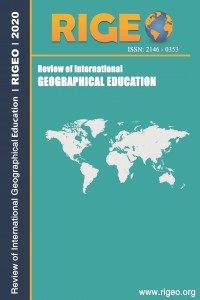Applying Virtual Reality Technology to Geoscience Classrooms
Applying Virtual Reality Technology to Geoscience Classrooms
Virtual reality, Geoscience, Geoscience Education, Learning gain Classroom, Smartphone,
___
- Anderson, L. W., & Krathwohl, D. R. (2001). A revision of Bloom’s taxonomy of educational objectives. A Taxonomy for Learning, Teaching and Assessing. Longman, New York.
- Arrowsmith, C., Counihan, A., & McGreevy, D. (2005). Development of a multi-scaled virtual field trip for the teaching and learning of geospatial science. International Journal of Education and Development using ICT, 1(3), 42-56.
- Bailey, J. E., Whitmeyer, S. J., & De Paor, D. G. (2012). Introduction: The application of Google Geo Tools to geoscience education and research. Geological Society of America Special Papers, 492, 7-19.
- Çaliskan, O. (2011). Virtual field trips in education of earth and environmental sciences. Procedia-Social and Behavioral Sciences, 15, 3239-3243.
- Carmichael, P., & Tscholl, M. (2013). Cases, simulacra, and Semantic Web technologies. Journal of Computer Assisted Learning, 29(1), 31-42.
- Dolphin, G., Dutchak, A., Karchewski, B., & Cooper, J. (2019). Virtual field experiences in introductory geology: Addressing a capacity problem, but finding a pedagogical one. Journal of Geoscience Education, 67(2), 114-130.
- Elkins, J. T., & Elkins, N. M. (2007). Teaching geology in the field: Significant geoscience concept gains in entirely field-based introductory geology courses. Journal of geoscience education, 55(2), 126-132.
- Esteves, H., Ferreira, P., Vasconcelos, C., & Fernandes, I. (2013). Geological fieldwork: A study carried out with Portuguese secondary school students. Journal of Geoscience Education, 61(3), 318-325.
- Fuller, I. C. (2012). Taking students outdoors to learn in high places. Area, 44(1), 7-13.
- Gilley, B., Atchison, C., Feig, A., & Stokes, A. (2015). Impact of inclusive field trips. Nature Geoscience, 8(8), 579.
- Hake, R. R. (1998). Interactive-engagement versus traditional methods: A six-thousand-student survey of mechanics test data for introductory physics courses. American journal of Physics, 66(1), 64-74.
- Hesthammer, J., Fossen, H., Sautter, M., Sæther, B., & Johansen, S. E. (2002). The use of information technology to enhance learning in geological field trips. Journal of Geoscience Education, 50(5), 528-538.
- Hurst, S. D. (1998). Use of “virtual” field trips in teaching introductory geology. Computers & Geosciences, 24(7), 653-658.
- Kaplan, A. M., & Haenlein, M. (2010). Users of the world, unite! The challenges and opportunities of Social Media. Business horizons, 53(1), 59-68.
- Kastens, K. (2010). Commentary: Object and spatial visualization in geosciences. Journal of Geoscience Education, 58(2), 52-57.
- King, C. (2008). Geoscience education: An overview. Studies in Science Education, 44(2), 187-222.
- Leydon, J., & Turner, S. (2013). The challenges and rewards of introducing field trips into a large introductory geography class. Journal of Geography, 112(6), 248-261.
- Liou, W. K., & Chang, C. Y. (2018, February). Virtual reality classroom applied to science education. In 2018 23rd International Scientific-Professional Conference on Information Technology, 1-4.
- Ma, X., Cackett, M., Park, L., Chien, E., & Naaman, M. (2018). Web-based VR experiments powered by the crowd. In Proceedings of the 2018 World Wide Web Conference, 33-43.
- Martínez-Graña, A., González-Delgado, J., Pallarés, S., Goy, J., & Llovera, J. (2014). 3D virtual itinerary for education using Google Earth as a tool for the recovery of the geological heritage of natural areas: Application in the “Las Batuecas Valley” nature park (Salamanca, Spain). Sustainability, 6(12), 8567-8591.
- McCaffrey, K. J. W., Jones, R. R., Holdsworth, R. E., Wilson, R. W., Clegg, P., Imber, J., Holliman, N., & Trinks, I. (2005). Unlocking the spatial dimension: digital technologies and the future of geoscience fieldwork. Journal of the Geological Society, 162(6), 927-938.
- Meagher, B. J., Cataldo, K., Douglas, B. J., McDaniel, M. A., & Nosofsky, R. M. (2018). Training of rock classifications: The use of computer images versus physical rock samples. Journal of Geoscience Education, 66(3), 221-230.
- Qiu, W., & Hubble, T. (2002). The advantages and disadvantages of virtual field trips in geoscience education. The China Papers, 1, 75-79.
- Stieff, M., Bateman, R. C., & Uttal, D. H. (2005). Teaching and learning with three-dimensional representations. In Visualization in science education. Springer, Dordrecht, 93-120.
- Welsh, K., & France, D. (2012). Spotlight on... Smartphones and fieldwork. Geography, 97, 47.
- Whitmeyer, S., Feely, M., De Paor, D., Hennessy, R., Whitmeyer, S., Nicoletti, J., Santangelo, B., Daniels, J., & Rivera, M. (2009). Visualization techniques in field geology education: A case study from western Ireland. Field geology education: Historical perspectives and modern approaches, 461, 105.
- ISSN: 2146-0353
- Başlangıç: 2011
- Yayıncı: Eyüp ARTVİNLİ
Why Geography Learning: Candidate Teachers’ Views for Geography
Learning Progressions, Paradigms, and Geographic Thinking in the Anthropocene
Thomas LARSEN, John HARRİNGTON, JR.
Worldview–An Investigation of Japanese and Irish Children’s Geographical Knowledge and Understanding
Shelagh WADDİNGTON, Takashi SHİMEDA
Psychosocial Achievements of Social Studies Teacher Candidates in Out door Geography CoursesCourses
Determination of Map Literacy of Undergraduate Geography Students
Discovery Learning Strategy in Geographical Education: A Sample of Lesson Design
Maria Anezilany GOMES DO NASCIMENTO
Applying Virtual Reality Technology to Geoscience Classrooms
Piyaphong CHENRAİ, Sukonmeth JİTMAHANTAKUL
Out-of-School Learning to Achieve the Spatial Perception Skills: A Case Study
